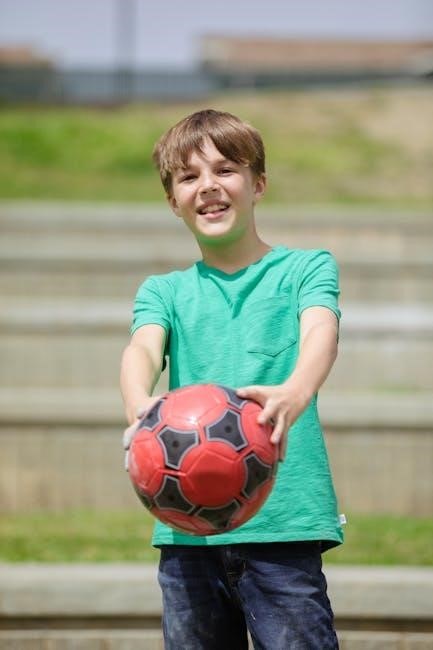Choosing the right youth soccer ball size is crucial for skill development, safety, and enjoyment. Properly sized balls ensure young players can control and maneuver effectively, fostering a love for the game while promoting proper techniques and reducing injury risks. Selecting age-appropriate sizes is essential for optimal performance and fun;
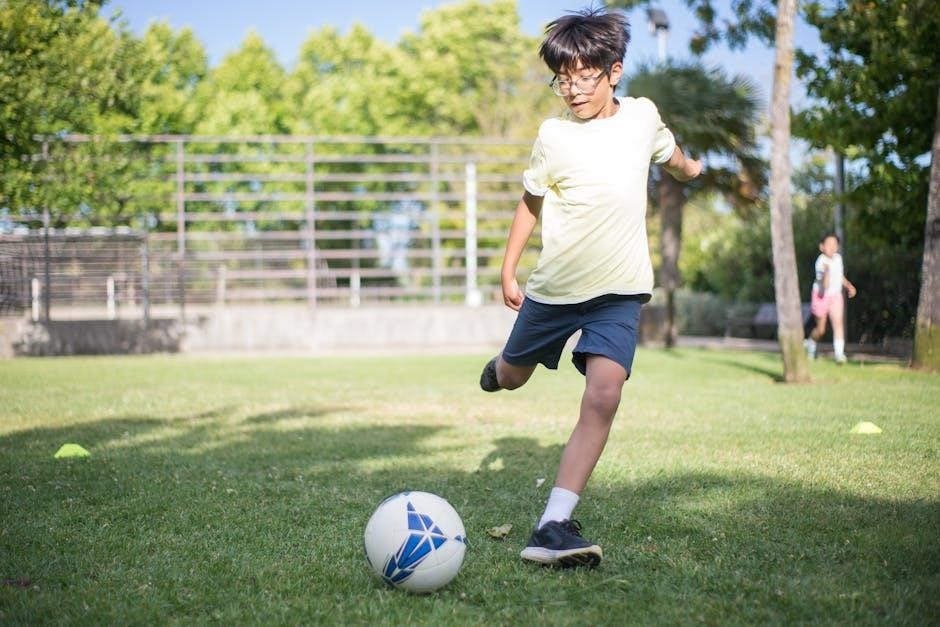
Why Choosing the Right Ball Size Matters
Choosing the right soccer ball size is essential for young players’ skill development and safety. A ball that is too large or too small can hinder proper technique and control, potentially leading to frustration or injury. The correct size ensures players can dribble, pass, and shoot effectively, fostering better gameplay and confidence. Properly sized balls also promotecomfort and reduce fatigue during training and matches.
Using the appropriate ball size, as recommended by FIFA and US Youth Soccer, helps young athletes develop fundamental skills like ball control and coordination. It also enhances their overall enjoyment of the game, making it more engaging and rewarding for players of all ages and skill levels.
Overview of Youth Soccer Ball Size Guide
The youth soccer ball size guide provides clear recommendations to help players, parents, and coaches select the appropriate ball for different age groups. Designed to promote proper skill development and safety, the guide categorizes balls into sizes 1, 3, 4, and 5, each tailored to specific age ranges. Size 1 is for training and young children, while sizes 3, 4, and 5 are for progressively older players. This guide ensures that young athletes use balls that match their physical abilities and game requirements, fostering better performance and enjoyment of the sport.
- Helps in selecting the right ball for skill development.
- Ensures safety and comfort for young players.
- Provides a clear framework for age-specific ball sizes.
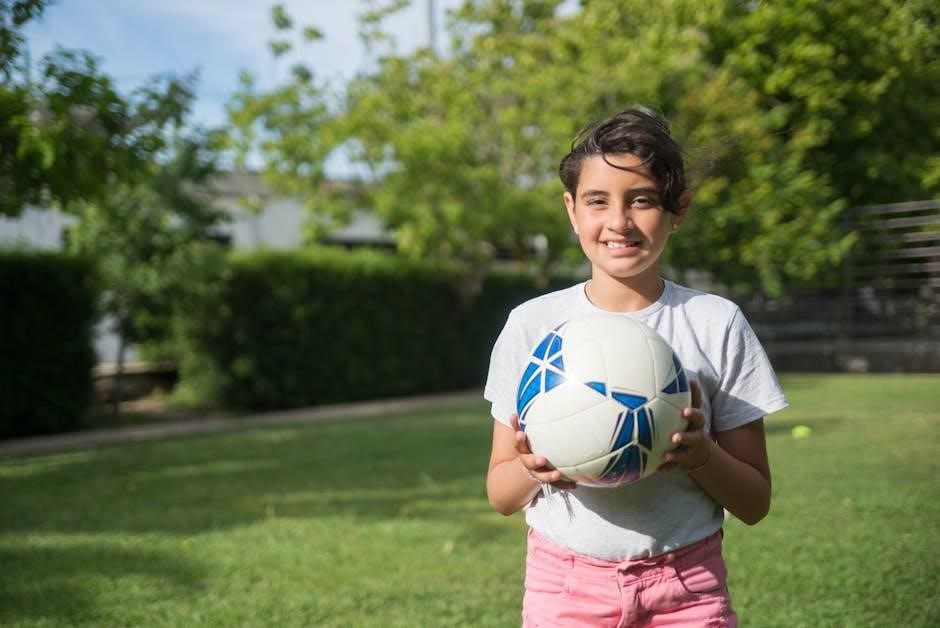
Official Soccer Ball Size Recommendations for Youth
Official guidelines recommend specific ball sizes for youth players: Size 3 for ages 7 and younger, Size 4 for ages 8-12, and Size 5 for ages 12 and older.
Size 3: Ages 7 and Younger
Size 3 soccer balls are designed for children aged 7 and younger, with a circumference of 23-24 inches. This smaller, lighter ball is ideal for developing basic skills like dribbling and ball control. Its reduced weight ensures safety and ease of handling for younger players. The smaller size allows for better precision and maneuverability, making the game more enjoyable and accessible for young athletes. This size is recommended by youth soccer organizations and leagues to promote proper technique development and fun. It’s perfect for training sessions and casual play, helping young players build confidence and a love for the game.
Size 4: Ages 8-12
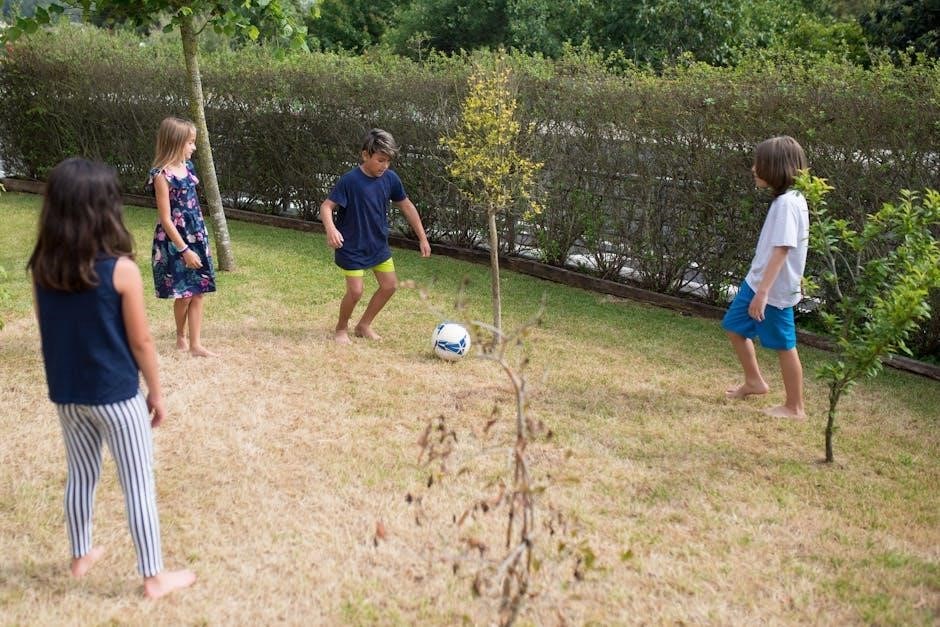
Size 4 soccer balls are recommended for children aged 8-12, with a circumference of 25-26 inches. This size is ideal for developing fundamental skills like passing, shooting, and dribbling. The ball’s weight and size are balanced, making it easier for pre-teen players to control during games and practices. Size 4 is the official ball for most youth leagues in this age group, ensuring consistency and fairness. It’s also lightweight enough to reduce the risk of injury while providing a realistic feel for the game. This size is crucial for building confidence and refining techniques as players transition to more competitive levels of soccer.
Size 5: Ages 12 and Older
Size 5 soccer balls are designed for players aged 12 and above, with a circumference of 27-28 inches. This is the standard size used in professional and adult leagues, making it ideal for older youth players transitioning to higher levels of play. The larger and heavier ball helps develop strength and precision, preparing players for the demands of competitive soccer. Size 5 is also the official ball for high school and college matches, ensuring consistency and challenge for advanced skill development. It’s essential for refining techniques and building stamina as players approach the pinnacle of their youth soccer careers.
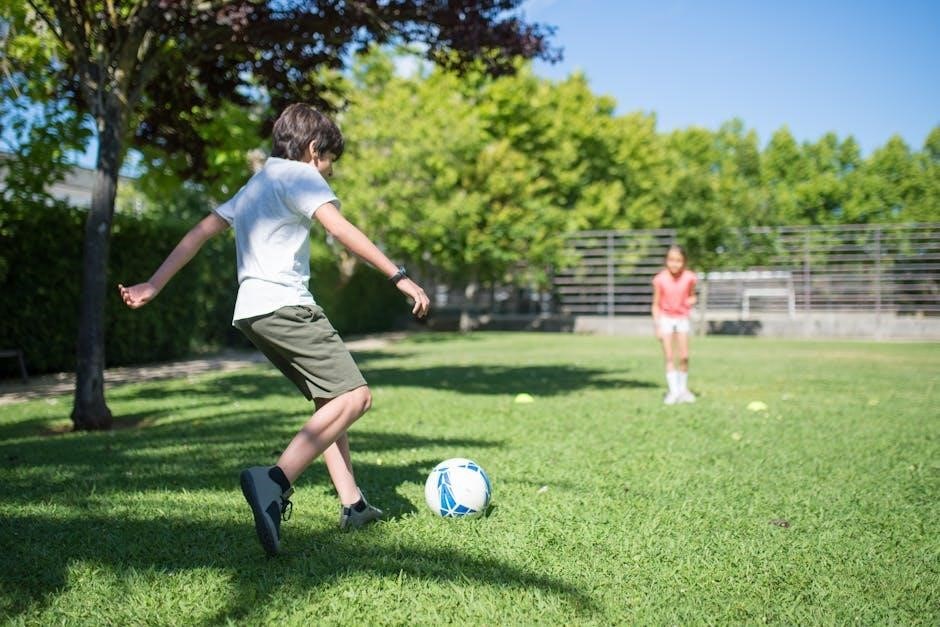
Understanding the Importance of Proper Ball Size
Proper ball size ensures young players develop skills effectively, stay safe, and enjoy the game. It promotes better technique, reduces injury risks, and enhances overall performance.
Impact on Skill Development
Proper ball size significantly impacts a young player’s ability to develop essential soccer skills. A ball that is too large or too small can hinder technique and coordination. For instance, a ball that is too big may be difficult for younger players to control, making it hard to master dribbling, passing, and shooting. Conversely, a ball that is too small may not allow older players to develop strength and power. Using the correct size ensures players can practice ball control effectively, improving their overall proficiency. Skill development is enhanced when the ball size matches the player’s age and ability, allowing for better precision and mastery of fundamental soccer techniques.
Safety Considerations
Using the correct ball size is essential for ensuring player safety in youth soccer. A ball that is too large or too small can lead to accidental injuries, particularly to the head or limbs. For younger players, a ball that is too heavy or oversized may cause strain or discomfort. Properly sized balls reduce the risk of mishandling and collisions during play. Additionally, the right ball size helps young players develop proper heading and striking techniques, minimizing the risk of overexertion or improper contact. Ensuring safety through appropriate ball size allows players to focus on skill development while reducing potential hazards during training and matches.
Player Comfort and Enjoyment
Using the correct ball size significantly enhances player comfort and enjoyment in youth soccer. A ball that is appropriately sized for a child’s age and skill level ensures they can control and maneuver it with ease. This makes the game more enjoyable and less frustrating, allowing young players to focus on developing their skills rather than struggling with an oversized or undersized ball. Properly sized balls also reduce fatigue and discomfort during play, as they are tailored to the player’s strength and ability. This ensures a more positive experience, fostering a lifelong love for the sport while keeping the game engaging and fun for all participants.
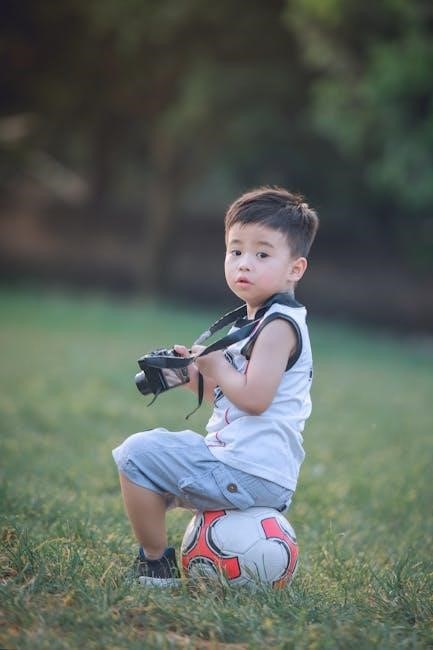
Youth Soccer Ball Size Chart
- Size 1: 45-50 cm circumference, suitable for all ages, especially toddlers and precision training.
- Size 3: 23-24 inches, ideal for players aged 5-8 years.
- Size 4: 25-26 inches, recommended for ages 8-12.
- Size 5: 27-28 inches, designed for players 12 and older.
Size 1: 45-50 cm Circumference
Size 1 soccer balls, measuring 45-50 cm in circumference, are the smallest and lightest option, making them ideal for toddlers and young children under 3 years old. Their compact size and reduced weight are perfect for developing basic motor skills and hand-eye coordination. Additionally, these balls are often used by players of all ages for precision training, as their smaller size challenges control and dribbling abilities. Size 1 balls are not used in competitive games but are excellent for practice and recreational play, helping young players build confidence and technique in a fun, engaging way.
Size 3: 23-24 Inches Circumference
Size 3 soccer balls, with a circumference of 23-24 inches, are designed for youth players aged 7 and younger. This smaller size is easier for young children to handle, making it ideal for developing fundamental skills like dribbling and ball control. The lighter weight and smaller dimensions allow for better maneuverability, helping young players build confidence and coordination. Size 3 balls are the smallest officially recommended for junior games, ensuring they meet the needs of developing athletes. They are a key tool for introducing young players to the game, providing an appropriate challenge and fostering a love for soccer at an early age.
Size 4: 25-26 Inches Circumference
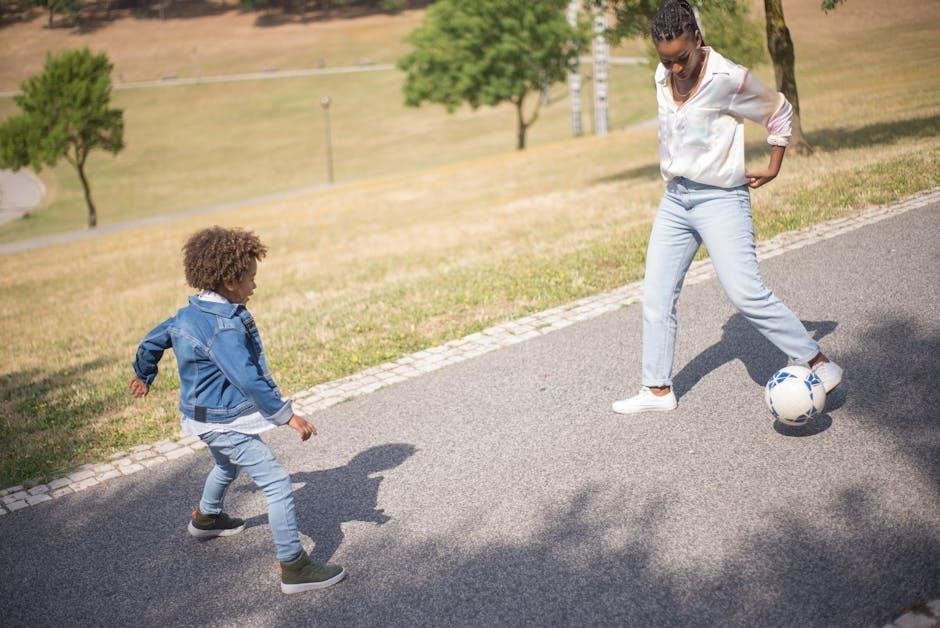
Size 4 soccer balls, measuring 25-26 inches in circumference, are recommended for players aged 8-12. This size is ideal for youth leagues, offering a balance between control and power. It aids in developing fundamental skills like passing and shooting, as the weight and size are appropriate for this age group. Transitioning from Size 3, Size 4 helps build strength and accuracy. The ball’s dimensions prepare players for the larger Size 5, fostering progression in their technique. Using the correct size enhances gameplay enjoyment and engagement, making it essential for young athletes to master the game comfortably and confidently.
Size 5: 27-28 Inches Circumference
Size 5 soccer balls, with a circumference of 27-28 inches, are the largest and most widely used, recommended for players aged 12 and older. This size is the official standard for professional and adult games, ensuring consistency across all levels. Its larger dimensions and weight provide a challenge for developing advanced skills, such as precise long passes and powerful shots. For youth players transitioning to this size, it enhances strength and technique, preparing them for competitive play. Size 5 is also used in training for older youth, helping them refine their abilities and adapt to the demands of higher-level soccer.

Additional Tips for Selecting the Right Ball
When selecting a soccer ball, consider material, weight, and inflation. Choose durable materials for longevity, ensure proper weight for age-appropriate control, and maintain optimal inflation for performance and safety.
Material and Weight Considerations
Selecting the right material and weight for a youth soccer ball is vital for performance and durability. Leather balls offer a traditional feel but require regular maintenance. Synthetic balls are more durable and water-resistant, making them ideal for training and younger players. PVC balls are lightweight and budget-friendly, suitable for beginners. Ensure the ball meets FIFA or USSF standards for quality and safety. Proper weight ensures ease of control and reduces injury risk. Lighter balls are recommended for younger players, while older players can handle standard weights. Always check the ball’s specifications to match the player’s age and skill level for optimal performance and safety.
Ball Inflation Best Practices
Proper ball inflation is essential for optimal performance and safety. Always follow the manufacturer’s recommended pressure, typically between 8.5 and 15.6 PSI. Use a pressure gauge for accuracy and avoid over-inflation, as it can make the ball too hard and increase injury risk. For leather balls, inflate slightly below maximum pressure to allow for natural expansion. Synthetic balls can handle higher pressures but should still adhere to guidelines. Check inflation before each game and practice, especially in changing weather conditions, as temperature affects air pressure. Properly inflated balls ensure better control, accurate flight, and durability, enhancing the overall playing experience for youth players.
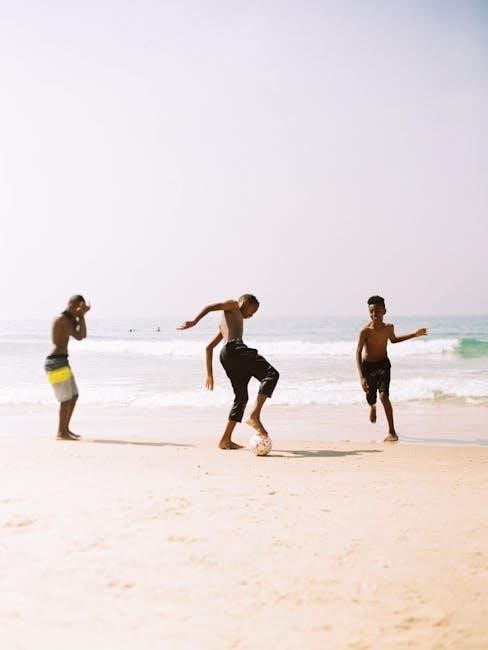
Frequently Asked Questions
What is the best ball size for youth players? Size 3 for ages 7 and younger, Size 4 for ages 8-12, and Size 5 for ages 12 and older. Always follow official guidelines for safety and performance.
What is the Best Ball Size for Training?
The best ball size for training depends on the player’s age and skill level. For younger players (ages 7 and younger), Size 3 balls are ideal as they are smaller and lighter, making them easier to control. For older youth players (ages 8-12), Size 4 balls are recommended as they provide a balance between size and weight, allowing for better technique development. Players aged 12 and older should use Size 5 balls, the same as professional players, to prepare for competitive play. Using the correct size ensures proper skill development and reduces the risk of injury during practice sessions.
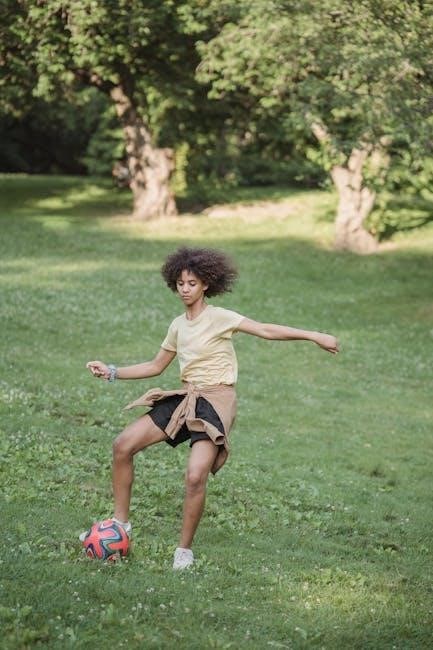
How to Measure Ball Circumference
To measure a soccer ball’s circumference, use a flexible tape measure or string. Wrap it around the ball’s midsection, ensuring it’s not compressed. Record the measurement in inches. For youth sizes, Size 3 should be 23-24 inches, Size 4 should be 25-26 inches, and Size 5 should be 27-28 inches. Proper inflation is key for accurate measurements. Compare the circumference to official guidelines to confirm the correct size. This ensures the ball meets age-specific standards, promoting proper skill development and safety for young players. Always double-check measurements to avoid errors in size selection.
